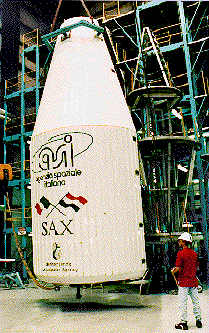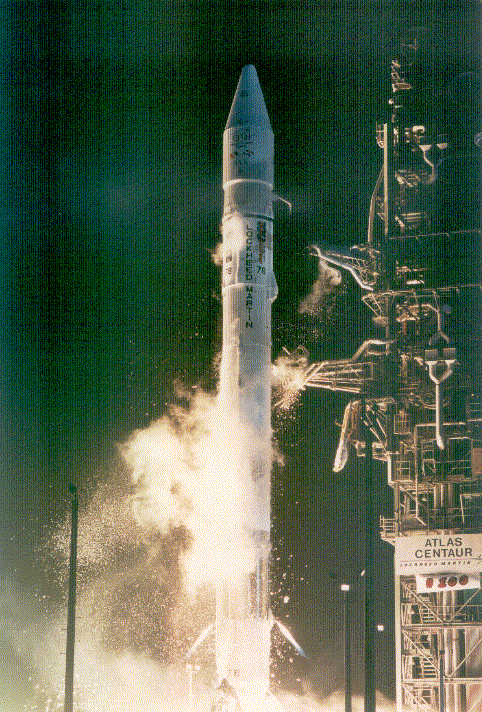


 BeppoSAX was launched by an
Atlas G-Centaur
directly into a 600 km orbit at
3.9 degrees inclination on April 30 1996 at 4:31 GMT.
BeppoSAX was launched by an
Atlas G-Centaur
directly into a 600 km orbit at
3.9 degrees inclination on April 30 1996 at 4:31 GMT.
The satellite nearly avoids the South Atlantic Anomaly and takes full advantage of the screening effect of the Earth magnetic field in reducing the cosmic ray induced background. Furthermore the choice of this orbit minimizes the modulation of the earth magnetic cut-off and consequently the modulation of the particle induced background. This is important in order to achieve the necessary sensitivity for observations of weak sources by the high energy experiments, particularly for the PDS.
A particular care in minimizing systematic effects in the background evaluation, particularly for the high energy collimated instruments, HPGSPC and PDS, has been pursued also at the instrument level adopting the techniques of rocking collimators and active gain equalization.
The satellite will achieve one arc-minute pointing stability with the same post facto attitude reconstruction accuracy.
The main attitude constraint derives from the need to maintain the normal to the solar arrays within 30 degrees from the sun, with occasional excursions to 45 degrees for some WFC observations. Therefore during a single orbit the NFI (Narrow Field Instruments) will have a band in the sky of 60 degrees wide available for observations (50% of the sky), and the WFC a slightly larger region. Observing efficiency will depend on target position due to the possible eclipse by Earth (which has a diameter of about 130 deg at 600 km).
During each orbit up to 450 Mbits of data will be stored onboard and relayed to ground during station passage. The average data rate available to instruments will be about 70 kbit/s, but peak rates of up to 100 kbit/s can be retained.
The satellite passes above the ground station, placed near the equator (Malindi, Kenya), every orbit. This will allow a prompt operation and control on the satellite, particularly important in the case of targets of opportunity (TOO) that need timely follow up observations. The Operational Control Center (OCC), located in Rome at Nuova Telespazio, is connected to the ground station by a relay satellite. The Scientific Data Center is located in the same place of the OCC, to optimize the interaction between the scientific and operational components.
 |
Questions should be addressed to: asdc_helpdesk@asdc.asi.it |